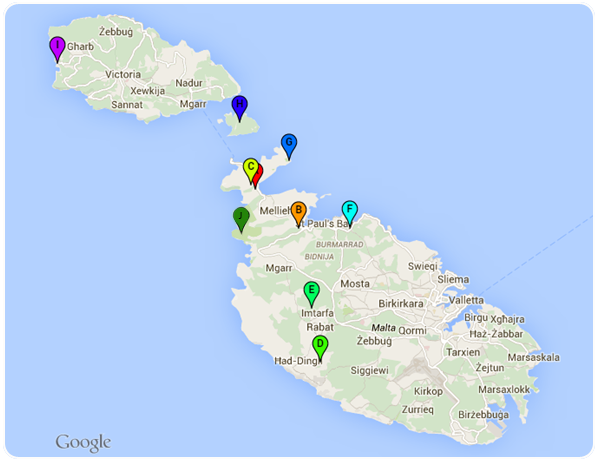Malta is a fantastic destination for birdwatching.
As an archipelago lying in the centre of the Mediterranean, Malta’s geographical position makes the islands an ideal location to watch migratory birds. The islands are unique because they lie along one of the main European-African migration flyways. Malta has an international importance out of scale with its diminutive size. A study conducted by BirdLife Malta showed that birds from at least 47 countries (35 in Europe and 12 in Africa) pass over Malta during migration periods. If you’re visiting the islands and want to see what bird life Malta has to offer, check out some our top birdwatching spots below:
A – Għadira Nature Reserve
B – Is-Simar Nature Reserve
C – Foresta 2000
D – Buskett Woodlands
E – Chadwick Lakes
F – Salina Salt Pans
G – Rdum tal-Madonna
H – Comino
I – Dwejra
J – Majjistral Nature and History Park
Għadira Nature Reserve
Għadira nature reserve is located in the north of Malta in on the outskirts of the town of Mellieħa. The seven hectare reserve comprises of brackish lake and saltmarsh habitat. Due to the dry climate in Malta, permanent areas of inland water are rare, making the Għadira wetlands are an extremely important habitat for birds and other wildlife. Around 140 species of migrating birds are seen annually. Most of the birds seen are migrants, stopping to rest and refuel before continuing their long migration journeys. Click here to find out more about the reserve.
Is-Simar Nature Reserve
Is-Simar is an oasis amongst a valley of agricultural landscape. The reserve takes its name from the sharp rush (Is-Simar in Maltese) which is regenerating throughout the reserve. The wetlands provide a safe haven for both resident and migrating birds. Made up of a mosaic of habitats including open pools, reedbed, and trees, Is-Simar is teeming with wildlife. The pools are attractive to aquatic birds like herons, rails and kingfishers, but also provide a home for the rare and protected Mediterranean Killifish and species of rare tassel-weed. Click here to find out more about the reserve.
Foresta 2000
Foresta 2000 is an area of natural habitat which has been restored as a Mediterranean woodland. Overlooking Għadira Bay the site stretches almost coast to coast offering not only diverse wildlife, but also fantastic views across the valley. The woodland is a mosaic comprised of steppe, woodland, garrigue and maquis habitat which provide shelter for birds, insects, mammals, reptiles and amphibians. This beautifully rich ecosystem has lots to offer visitors looking to immerse themselves into typically Mediterranean nature. Click here to find out more about the site.
Buskett Woodlands
Buskett is a small area of mature woodland in the south of Malta and is one of the greenest places in the Maltese Islands. Once used as a hunting grounds, the area is now a bird sanctuary, so no hunting or tapping is permitted. Due to the high altitude, Buskett is the best place on the islands to watch migrating raptors in the autumn. During late September, visit in the evening to see Honey Buzzards, Marsh Harriers, Kestrels, Hobbys and if you’re lucky some rarer sights such as Short-toed Eagles and Ospreys.
Chadwick Lakes
Chadwicks Lakes is a valley between Rabat and Mtarfa which is home to artificial freshwater lakes. The lakes were originally built in 1890 by British engineer, Osbert Chadwick, to provide local farmers with a source of fresh water to irrigate their fields. Now, the rain collected in the lakes also provides a watery habitat for many species of plants and animals. Visit in winter to see the lakes at their best, and look out for shy warbler species along the way.
Salina Saltpans
The salt pans in Malta can be found between Baħar Iċ-Ċagħaq and Qawra in the north of Malta. The area is a bird sanctuary, meaning no hunting or trapping is permitted. With the saltpans providing an ideal habitat for wadin birds, stop by in summer to see Greenshank, Black-winged Stilts, stints and plovers. It is also a perfect resting spot for flamingos to feed and rest on their migration journeys around the Mediterranean.
Rdum tal-Madonna
Rdum tal-Madonna is an important bird area and Natura 2000 site found near L-Ahrax, in the North of Malta. The area gains its IBA status due to a breeding colony of Yelkouan Shearwaters in the cliffs along the coast. The area is also a great location for spotting pipits and wheatears, as well as Malta’s national bird, the Blue Rock Thrush.
Comino
Comino is a small rocky island situated between Malta and Gozo. The island is both a bird sanctuary and an Important Bird Area, making it a safe resting spot for migratory birds. On the island you can see migrating raptors, bee-eaters, hoopoes and many other migratory birds. BirdLife Malta runs a ringing project twice a year in spring and in autumn, making April and October the best times to visit.
Dwejra, Gozo
Dwejra is a popular location for tourists visiting the Azure Window, but the cliffs there also make it a great spot for birdwatching. Look out for birds migrating at sea such as Little Egrets, and wagtails and flycatcher in the rocky fields surrounding. Spring and autumn migration seasons are the best times to visit Dwejra.
Majjistral Nature and History Park
Majjistral Nature and History Park is situated in northwest Malta and is the island’s first natural national park. With a 6km of protected coastline and interesting archaeological sites, the park is also home to over 430 species of plants, nine breeding bird species plus several migratory species which visit each year. The diverse habitats of the park including clay slopes, boulder screes and a sandy beach means you can also spot a number of small mammals including hedgehogs and weasels.

